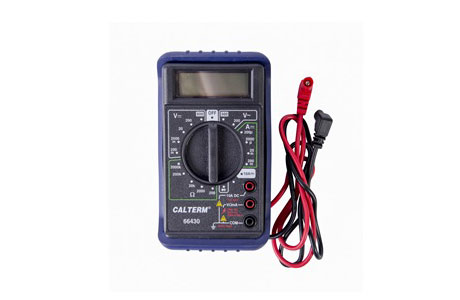Key Takeaway
To measure temperature with a multimeter, you’ll need a multimeter that supports temperature measurement and a thermocouple probe. First, connect the thermocouple to the multimeter’s temperature input. Set the multimeter to the temperature mode, usually marked with a degree symbol. Place the thermocouple probe on or near the object whose temperature you want to measure.
The multimeter will display the temperature reading in Celsius or Fahrenheit. This method is useful for checking the temperature of various devices or environments, ensuring they operate within safe limits.
Introduction to Temperature Measurement Using Multimeters
Measuring temperature using multimeters involves understanding the additional features and attachments that some multimeters provide. Many modern multimeters come with temperature measurement capabilities, which require a thermocouple probe. This probe is connected to the multimeter and placed on or near the object whose temperature is to be measured. The multimeter then provides a temperature reading, which is crucial in applications where temperature monitoring is necessary.
This feature can be particularly useful in HVAC systems, automotive diagnostics, and various industrial processes. In this introduction, we will explore how multimeters can be used for temperature measurements and the significance of this feature in diverse applications.

Tools Needed for Accurate Temperature Testing
For accurate temperature testing, a multimeter with a temperature probe is essential. To perform temperature measurements, you’ll need the following tools:
1. Multimeter with Temperature Capability: Ensure the multimeter you are using has the ability to read temperature. Many modern digital multimeters include this feature, typically with a special temperature probe.
2. Temperature Probe: This is a specific probe that attaches to the multimeter and measures temperature. Thermocouple probes are commonly used for accurate temperature readings.
3. Thermometer Calibration: Before use, ensure the temperature probe is calibrated to ensure accurate readings. Improperly calibrated probes can lead to incorrect temperature measurements.
4. Safety Equipment: If measuring high temperatures or working with live circuits, ensure you are using appropriate safety equipment such as gloves, eye protection, and insulating materials.
Accurate temperature testing is important in a variety of applications, including HVAC systems, electronics, and industrial processes.
Setting Up Your Multimeter with a Temperature Probe
Using a temperature probe with your multimeter can help you measure temperature accurately in electrical and mechanical systems. Here’s how to set it up:
1. Select the Temperature Mode: Turn your multimeter dial to the temperature mode, often indicated by a thermometer symbol.
2. Attach the Temperature Probe: Insert the temperature probe into the multimeter’s temperature input port (often marked as T).
3. Insert the Probes into the Circuit: Attach the temperature probe to the area you want to measure, such as the surface of a component or the surrounding air.
4. Read the Temperature: The temperature will be displayed in Celsius (°C) or Fahrenheit (°F), depending on the setting. Compare the readings to ensure that components are not overheating.
Applications of Multimeter Temperature Measurements
Multimeters equipped with temperature probes can measure the temperature of electrical components, providing crucial information for both troubleshooting and system optimization. Here are some key applications of temperature measurements using a multimeter:
1. Component Temperature Monitoring: Temperature is a vital indicator of component health. High temperatures can cause component failure, especially in sensitive devices like transistors and capacitors. By using a temperature probe, you can monitor the temperature of these components to ensure they’re operating within safe limits.
2. Circuit Overheating Detection: If a circuit is experiencing excessive current draw, it could overheat, leading to failure. Measuring the temperature of wires and connectors in the circuit can help detect overheating before it causes a problem, allowing for early intervention.
3. Battery Monitoring: Overheating batteries can be dangerous and are often a sign of internal damage or an improper charging circuit. Using a temperature probe with your multimeter allows you to monitor the temperature of batteries in real-time, helping to avoid risks such as explosions or leaks.
4. Troubleshooting Motors and Transformers: Electric motors and transformers can overheat due to poor efficiency or a malfunction. Measuring the temperature of these devices helps identify overheating issues, which could be a sign of mechanical failure, faulty windings, or inadequate ventilation.
5. Environmental Temperature Measurements: When working in environments where ambient temperature can affect the performance of electrical equipment, temperature probes help ensure that devices are operating within their recommended temperature range, preventing malfunction due to extreme environmental conditions
Common Errors and How to Avoid Them in Temperature Testing
Temperature testing errors are often due to improper probe placement. Ensure the thermocouple or temperature probe is securely attached to the measured surface for accurate readings.
Using an incompatible probe or failing to calibrate it with the multimeter can also cause errors. Always check that your multimeter supports temperature measurements and is correctly configured.
Environmental factors like airflow or rapid temperature changes can affect results. Performing measurements in controlled conditions minimizes these errors. Regularly inspecting and maintaining the probe ensures long-term accuracy.
Conclusion
In conclusion, measuring temperature with a multimeter requires the use of a thermocouple attachment, a feature available in certain multimeter models. This tool is useful for applications where you need to monitor temperature fluctuations, such as in HVAC systems or electrical components.
To get accurate readings, ensure that your multimeter is set to the correct temperature scale and the thermocouple is properly connected. Temperature measurements should be taken carefully, as inaccurate readings can lead to improper diagnostics. Always double-check your setup before taking measurements to ensure reliable results
